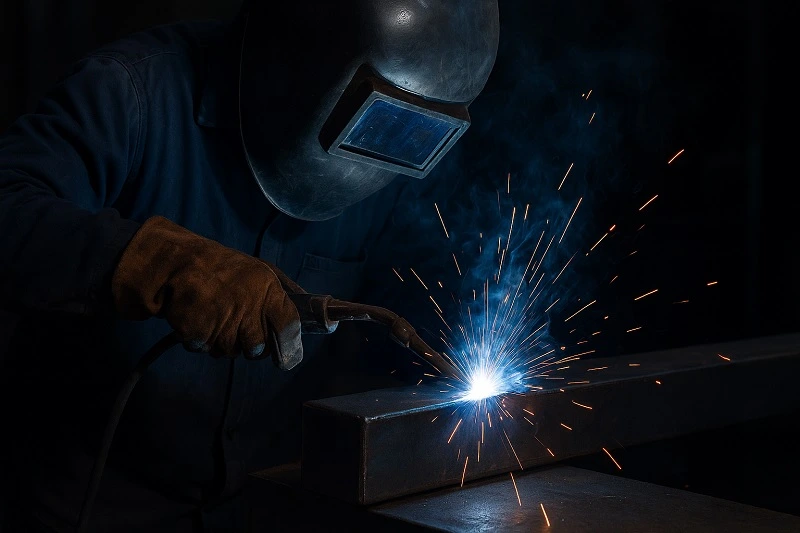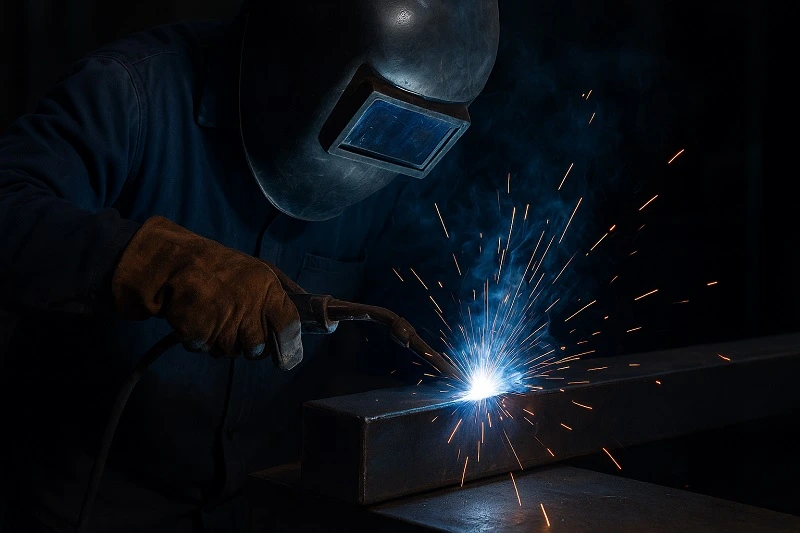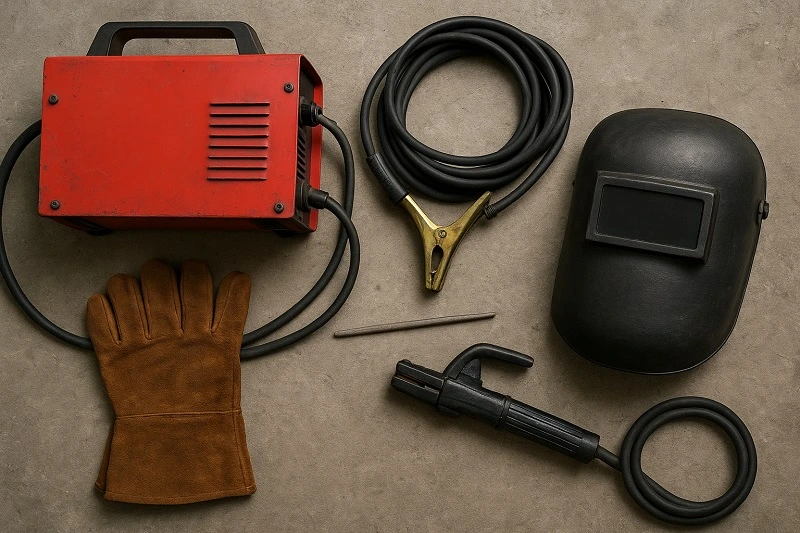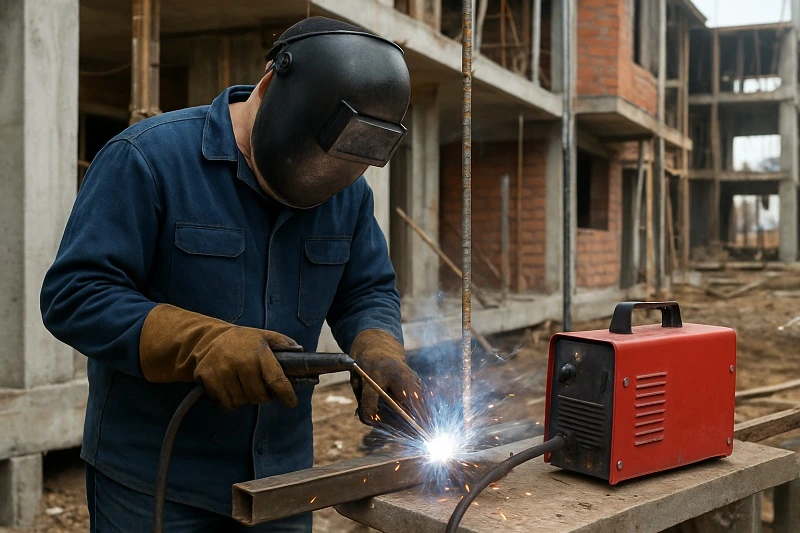
Shielded Metal Arc Welding (SMAW) — widely known as stick welding — is one of the most versatile and reliable arc welding processes used across construction, repair, and heavy-industry applications. Using a flux-coated electrode and an electric arc formed with the workpiece, SMAW delivers strong, deep welds without the need for external shielding gas, making it ideal for outdoor and field conditions. Its equipment is simple, portable, and cost-effective, though the process requires skill and produces more spatter and fumes than modern methods. This guide covers how SMAW works, its key benefits, limitations, and common industrial uses.
Stick Welding, or as welders casually call it in the shop, “stick,” is one of the oldest and most fundamental welding processes — yet it continues to dominate the metalworking world. Its official technical name may sound a bit formal (Shielded Metal Arc Welding / SMAW), but the concept behind it is surprisingly simple:
There is a metal rod coated with a thick layer of compressed flux. When you strike an arc between this electrode and the metal surface, the arc becomes so hot that it melts both the electrode tip and the base metal, fusing the pieces together.
One of the key reasons stick welding is so popular is that it doesn’t require external shielding gas. The electrode coating burns off during welding, creating its own protective shielding gas and forming a solid slag layer over the weld to prevent contamination. Because the equipment is compact, rugged, and easy to carry, SMAW is often the first choice for outdoor repairs, construction work, heavy-duty projects, and situations with limited access.

To understand why stick welding (SMAW / MMA) is so useful, you need to see what happens during the process. It all starts when you power up the welder and strike an electric arc. When you bring the electrode close to the workpiece, a controlled short-circuit occurs and the arc temperature shoots up to several thousand degrees. That extreme heat triggers two things at once:
Since the stick welding doesn’t require complex equipment and can be performed almost anywhere, here is a practical and step-by-step guide to help you understand how to weld with a flux-coated electrode safely and effectively.
Start with proper protective gear:
Prepare the workspace by removing flammable materials, securing the workpiece, and ensuring good lighting. Stick welding produces fumes and gases, so if you’re indoors, use ventilation or an extraction hood to maintain airflow.
Choose the electrode based on the base metal and joint type. for carbon steel, common choices include E6013 or E7018, depending on penetration and finish requirements.
Check the amperage range on the electrode package and set your welder accordingly. Attach the ground clamp firmly to the workpiece so the electrical circuit is stable. Then secure the electrode into the holder.
To start the arc, tap or drag the electrode briefly across the metal surface — similar to striking a match. The goal is to create a stable arc without the electrode sticking. If it sticks frequently, your amperage may be too low or your angle and distance may need adjustment.
Keep the arc length roughly equal to the electrode core diameter
(e.g., for a 2.5 mm electrode, hold about 2–3 mm distance).
A typical travel angle is 20–30° in the direction of movement. Choose push or pull depending on the electrode type, joint design, and desired penetration. Maintain a steady travel speed — too slow overheats the pool, and too fast causes lack of fusion. For wide joints, use weaving patterns; for narrow seams, a straight-line motion usually works best.
As you reach the end of the bead or the electrode burns short, slowly pull the electrode back to extinguish the arc smoothly. Let the weld cool slightly so the slag can harden.
Use a chipping hammer and wire brush to remove the slag and reveal the bead.
Inspect for common defects such as undercut, porosity, lack of penetration, or surface cracks.
If necessary, clean and weld again to correct the issue.
Unlike more complex processes such as TIG or MIG, stick welding doesn’t require many tools — but the few essentials it does use must function properly and safely to ensure a clean, reliable weld.

This is the heart of the setup. A welding machine converts electrical power into AC or DC output to establish the arc between the electrode and the metal.
For heavy industrial work, DC machines are typically favored due to their stable arc and deeper penetration.
If you’re comparing or shopping for machines, check reputable sources for welding and cutting power supplies to ensure proper performance and safety.
A thick, durable cable and a solid ground clamp are essential for maintaining a stable electrical circuit between the machine and the workpiece. A loose clamp or damaged cable leads to unstable arc performance and poor weld quality. Always inspect your connections before starting.
This is the insulated handle that grips the electrode. The insulation must be intact, and the jaws should hold the rod firmly. An ergonomic design makes angle control and travel easier, especially during long welding sessions.
A metal stick coated in mineral flux that melts during welding. Electrodes are identified by codes such as E6013, E7018, etc. These numbers describe mechanical properties and arc characteristics. For example: 7018 indicates roughly 70,000 psi tensile strength.
After welding, the bead is covered with slag produced by the flux. You’ll need a slag hammer to chip it away and a wire brush to clean the surface so you can inspect the weld quality clearly.
Essential protective equipment includes:
One reason this method is still popular in 2025 is its simplicity, portability, and impressive adaptability. Nearly every industry that works with metal uses SMAW in some form.

Used extensively for beams, columns, brackets, and metal frameworks.
It requires minimal power and is highly portable, making it ideal for onsite projects.
One of SMAW’s biggest advantages is its ability to work in remote or outdoor environments.
It’s commonly used for repairing pipelines, machinery frames, cracked industrial components, and other onsite fixes.
SMAW is widely used in pipeline welding, pressure vessels, and heavy structural components.
It provides durable welds and is less sensitive to wind and weather compared to MIG welding.
Because ships use thick steel plates, SMAW offers excellent penetration.
It also performs well in humid or windy coastal environments.
As one of the most fundamental welding processes, SMAW is typically the first method taught to beginners.
It’s affordable, straightforward, and ideal for learning arc control.